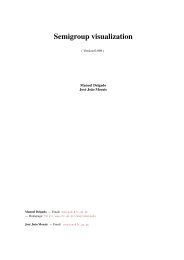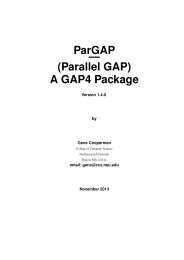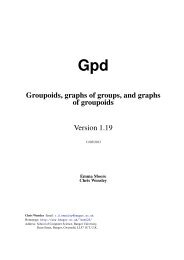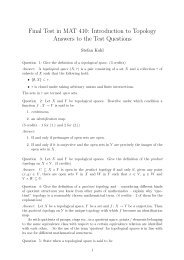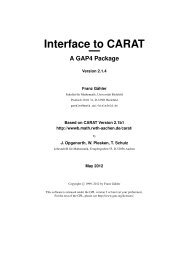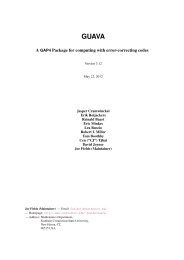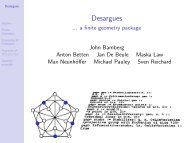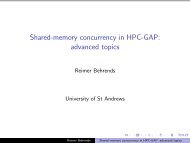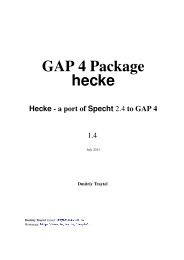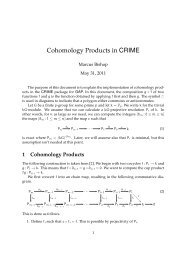SIMPLE GROUPS GENERATED BY INVOLUTIONS ... - Gap
SIMPLE GROUPS GENERATED BY INVOLUTIONS ... - Gap
SIMPLE GROUPS GENERATED BY INVOLUTIONS ... - Gap
Create successful ePaper yourself
Turn your PDF publications into a flip-book with our unique Google optimized e-Paper software.
<strong>SIMPLE</strong> <strong>GROUPS</strong> <strong>GENERATED</strong> <strong>BY</strong> <strong>INVOLUTIONS</strong> INTERCHANGING<br />
RESIDUE CLASSES MODULO LATTICES IN Z d<br />
STEFAN KOHL<br />
ABSTRACT. We present a series of countable simple groups, whose generators are involutions<br />
which interchange disjoint residue classes modulo lattices in Z d (d ∈ N). This work<br />
is motivated by the famous 3n + 1 conjecture.<br />
1. INTRODUCTION<br />
This paper continues the work which has been carried out in [1]. The subject of that<br />
article is the discussion of the following simple group, which is generated by involutions<br />
interchanging disjoint residue classes of the integers:<br />
Definition 1.1. Let CT(Z) be the group generated by the set of all class transpositions:<br />
Given disjoint residue classes r 1 (m 1 ) and r 2 (m 2 ) of Z, we define the class transposition<br />
τ r1(m 1),r 2(m 2) ∈ Sym(Z) as the permutation which interchanges r 1 + km 1 and r 2 + km 2<br />
for each integer k and which fixes all other points. Here we assume that 0 r 1 < m 1 and<br />
that 0 r 2 < m 2 .<br />
In this article, we generalize this construction to groups acting on Z d (d ∈ N):<br />
Definition 1.2. Let d ∈ N, and let L 1 , L 2 ∈ Z d×d be matrices of full rank which are in<br />
Hermite normal form. Further let r 1 +Z d L 1 and r 2 +Z d L 2 be disjoint residue classes, and<br />
assume that the representatives r 1 and r 2 are reduced modulo Z d L 1 and Z d L 2 , respectively.<br />
Then we define the class transposition τ r1+Z d L 1,r 2+Z d L 2<br />
∈ Sym(Z d ) as the involution<br />
which interchanges r 1 + kL 1 and r 2 + kL 2 for all k ∈ Z d .<br />
Definition 1.3. We denote the group which is generated by the set of all class transpositions<br />
of Z d by CT(Z d ).<br />
Obviously, the group CT(Z d1 ) embeds into CT(Z d2 ) if d 1 d 2 . Therefore the class<br />
of subgroups of CT(Z d ) is in particular at least not smaller than the class of subgroups of<br />
CT(Z), which is exhibited to a certain extent in [1].<br />
The purpose of this article is to prove the following:<br />
Theorem 1.4. Let d ∈ N. Then the group CT(Z d ) is simple.<br />
In [1], the author has shown that this holds in case d = 1. The purpose of this article is<br />
to treat the case d > 1.<br />
Originally, the work which led to the discovery of the simple group CT(Z) has been<br />
motivated by the famous 3n+1 conjecture. This conjecture asserts that iterated application<br />
of the so-called Collatz mapping<br />
{<br />
n/2 if n is even,<br />
T : Z −→ Z, n ↦−→<br />
(3n + 1)/2 if n is odd<br />
2000 Mathematics Subject Classification. Primary 20E32, secondary 20B40, 20B22, 20-04.<br />
1
2 STEFAN KOHL<br />
to a positive integer yields 1 after a finite number of steps. This conjecture has been<br />
made by Lothar Collatz in the 1930s, and is still open today. Lagarias [3] has compiled a<br />
comprehensive annotated bibliography on this conjecture, which currently lists more than<br />
200 references. A survey article and a monograph on Collatz’ conjecture are [2] and [4],<br />
respectively.<br />
The elements of the group CT(Z) are bijective mappings which are ‘similar to T ’ in the<br />
sense that they are affine on residue classes as well. If one investigates the group CT(Z)<br />
by means of theory or by means of computation, it turns out that its subgroups and its<br />
elements can often be handled much easier than T . So it seems that part of the problem is<br />
that Collatz’ mapping T is not injective.<br />
However, a key observation is now that the mapping T can be extended in natural ways<br />
to permutations of Z 2 . An example of such an extension is<br />
⎧<br />
⎪⎨ (2m + 1, (3n + 1)/2) if n is odd,<br />
σ T ∈ Sym(Z 2 ) : (m, n) ↦−→ (2m, n/2) if n ≡ 4 mod 6,<br />
⎪⎩<br />
(m, n/2)<br />
otherwise.<br />
This motivates a move from Z to Z 2 , and generalizing further, to Z d for d ∈ N.<br />
2. BASIC TERMS<br />
In this section we introduce some basic terms which will be needed to prove the simplicity<br />
of CT(Z d ).<br />
Definition 2.1. Let d ∈ N. We call a mapping f : Z d → Z d residue-class-wise affine<br />
if there is a lattice L = Z d M where M ∈ Z d×d is a matrix of full rank, such that the<br />
restrictions of f to the residue classes r + L ∈ Z d /L are all affine. This means that for any<br />
residue class r + L ∈ Z d /L, there is a matrix A r+L ∈ Z d×d , a vector b r+L ∈ Z d and a<br />
positive integer c r+L such that the restriction of f to r + L is given by<br />
f| r+L : r + L −→ Z d , v ↦−→ v · A r+L + b r+L<br />
c r+L<br />
.<br />
For reasons of uniqueness, we assume that L is chosen maximal with respect to inclusion,<br />
and that no prime factor of c r+L divides all coefficients of A r+L and b r+L .<br />
We call the lattice L the modulus of f, written Mod(f).<br />
We define the prime set of f as the set of all primes which divide the determinant of at<br />
least one of the coefficients A r+L or which divide the determinant of M.<br />
We call the mapping f class-wise translating if all coefficients A r+L are identity matrices<br />
and all coefficients c r+L are equal to 1.<br />
For the sake of simplicity, we identify a lattice with the Hermite normal form of the<br />
matrix by whose rows it is spanned.<br />
It is easy to see that the residue-class-wise affine permutations of Z d form a countable<br />
supergroup of CT(Z d ).<br />
Definition 2.2. We denote the group which is formed by all residue-class-wise affine permutations<br />
of Z d by RCWA(Z d ), and call its subgroups residue-class-wise affine groups.<br />
A more or less immediate observation is the following:<br />
Theorem 2.3. The groups CT(Z d ) and RCWA(Z d ) are not finitely generated.
<strong>SIMPLE</strong> <strong>GROUPS</strong> <strong>GENERATED</strong> <strong>BY</strong> <strong>INVOLUTIONS</strong> INTERCHANGING RESIDUE CLASSES 3<br />
Proof. It is easy to see that the prime set of a product of residue-class-wise affine permutations<br />
is a subset of the union of the prime sets of the factors, and that inversion leaves<br />
the prime set invariant. Therefore as there are infinitely many primes and as for any<br />
prime p there is a class transposition τ (1,0,...,0)+Zd·diag(2,1,...,1),(0,0,...,0)+Z d·diag(2p,1,...,1)<br />
whose prime set is {p}, the assertion follows.<br />
□<br />
3. THE SIMPLICITY OF CT(Z d )<br />
The aim of this section is to show that the groups CT(Z d ) are simple. For this we need<br />
some lemmata:<br />
Lemma 3.1. Given any two class transpositions τ r1+L 1,r 2+L 2<br />
and τ r3+L 3,r 4+L 4<br />
whose<br />
support is not all of Z d , there is always a product π of 6 class transpositions such that<br />
τ π r 1+L 1,r 2+L 2<br />
= τ r3+L 3,r 4+L 4<br />
.<br />
Proof. Let r 5 + L 5 , r 6 + L 6 ⊂ Z d \ (r 1 + L 1 ∪ r 2 + L 2 ) be disjoint residue classes such<br />
that ∪ 6 i=3 r i + L i ≠ Z d , and let r 7 + L 7 , r 8 + L 8 ⊂ Z d \ ∪ 6 i=3 r i + L i be disjoint residue<br />
classes. Then the following hold:<br />
(1) τ τ r1+L r1+L 1,r 5+L 5<br />
· τ r2+L 2,r 6+L 6 1,r 2+L 2 = τr5+L 5,r 6+L 6<br />
.<br />
(2) τ τ r5+L r5+L 5,r 7+L 7 · τ r6+L 6,r 8+L 8 5,r 6+L 6 = τr7+L 7,r 8+L 8<br />
.<br />
(3) τ τ r3+L r7+L 3,r 7+L 7<br />
· τ r4+L 4,r 8+L 8 7,r 8+L 8 = τr3+L 3,r 4+L 4<br />
.<br />
The assertion follows.<br />
□<br />
Lemma 3.2. Let σ, υ ∈ RCWA(Z d ), and put L := Mod(σ). If the mapping υ is classwise<br />
translating and fixes all residue classes (mod L) setwise, then the commutator [σ, υ]<br />
is class-wise translating as well.<br />
Proof. Since υ fixes all residue classes (mod L), an affine partial mapping α of [σ, υ] is<br />
given by α ασ<br />
υ<br />
· α −1 υ for certain affine partial mappings α σ , α υ and α υ −1 of σ, υ and υ −1 ,<br />
respectively. The assertion follows, since the translations form a normal subgroup of the<br />
affine group of Q d .<br />
□<br />
Lemma 3.3. Let G be a subgroup of RCWA(Z d ) which contains CT(Z d ). Then any<br />
nontrivial normal subgroup N ✂ G has a class-wise translating element ι ≠ 1.<br />
Proof. Let σ ∈ N \{1}, and put L := Mod(σ). Without loss of generality, we can assume<br />
that σ is not class-wise translating. We pick a residue class r + L such that σ| r+L is not<br />
a translation. By Lemma 3.2, the mappings ι i,j,k := [σ, τ r+iLj+2kL,r+(i+k)L j+2kL] ∈ N<br />
(k ∈ N, i ∈ {0, . . . , k − 1}, j ∈ {1, . . . , d}) are class-wise translating. If we choose<br />
k sufficiently large, then σ does not map all residue classes r + iL j + kL to themselves.<br />
Therefore not all ι i,j,k are equal to 1.<br />
□<br />
Now we can prove our theorem:<br />
Theorem 3.4. The groups CT(Z d ) are simple.<br />
Proof. Let d ∈ N, and let N be a nontrivial normal subgroup of CT(Z d ). We have to show<br />
that N contains all class transpositions.<br />
By Lemma 3.1, all class transpositions whose support is not all of Z d are conjugate in<br />
CT(Z d ). Further, any class transposition can be written as a product of two class transpositions<br />
with disjoint supports: putting D := diag(1, . . . , 1, 2), we have τ r1+L 1,r 2+L 2<br />
=<br />
τ r1+DL 1,r 2+DL 2<br />
· τ r1+L 1,d +DL 1,r 2+L 2,d +DL 2<br />
. Therefore it is already sufficient to show<br />
that N contains one class transposition whose support is a proper subset of Z d .
4 STEFAN KOHL<br />
By Lemma 3.3, the normal subgroup N has a class-wise translating element ι 1 ≠ 1. Let<br />
L be a sublattice of the modulus of ι 1 such that |Z/L| 3, and choose a residue class r+L<br />
which is moved by ι 1 . Then put ˜L := DL and ι 2 := τ r+ ˜L,r+Ld + ˜L ·τ (r+ ˜L) ι 1 ,(r+L d + ˜L) ι 1<br />
=<br />
[τ r+ ˜L,r+Ld + ˜L , ι 1] ∈ N.<br />
By the choice of L, we can now choose two distinct residue classes r 1 + ˜L and r 2 + ˜L<br />
in the complement of the support of ι 2 . Putting ˆL := D 2 L, we have now<br />
τ r1+ ˜L,r 2+ ˜L<br />
= ιτ r+ ˜L,r 1 + ˆL·τ r+L d + ˜L,r 2 + ˆL<br />
2<br />
· ι τ r+ ˜L,r 1 +2L d + ˆL·τ r+L d + ˜L,r 2 +2L d + ˆL<br />
2 ∈ N,<br />
which completes the proof of the theorem.<br />
Definition 3.5. Given a set P of odd primes, let CT P (Z d ) CT(Z d ) denote the subgroup<br />
which is generated by all class transpositions whose prime sets are subsets of P ∪ {2}.<br />
Corollary 3.6. The groups CT P (Z d ) are simple. Therefore the group CT(Z d ) has an<br />
uncountable series of simple subgroups, which is parametrized by the sets of odd primes.<br />
Proof. All of our arguments in this section apply to the groups CT P (Z d ) as well: In the<br />
proof of Lemma 3.1, we can choose the four residue classes r 5 + L 5 , . . . , r 8 + L 8 in such a<br />
way that all prime factors of the determinants of their moduli already divide the determinant<br />
of one of L 1 , . . . , L 4 . The proofs of Lemma 3.2, Lemma 3.3 and Theorem 3.4 likewise<br />
do not require the presence of class transpositions whose moduli have determinants with<br />
certain odd factors.<br />
□<br />
□<br />
4. THE PERMUTATION σ T<br />
In this section, we will have a closer look at the permutation<br />
⎧<br />
⎪⎨ (2m + 1, (3n + 1)/2) if n is odd,<br />
σ T ∈ RCWA(Z 2 ) : (m, n) ↦−→ (2m, n/2) if n ≡ 4 mod 6,<br />
⎪⎩<br />
(m, n/2)<br />
otherwise<br />
introduced above.<br />
The 3n + 1 conjecture asserts that any cycle of this permutation which contains a point<br />
(m, n) with n > 0 intersects nontrivially with the line n = 1, or equivalently that the first<br />
coordinates of the points of any cycle take only finitely many distinct even values.<br />
First we observe that any cycle of the permutation σ T lies entirely in one of the quadrants<br />
Q 1 := {(m, n) ∈ Z 2 : m, n 0}, Q 2 := {(m, n) ∈ Z 2 : m 0, n < 0},<br />
Q 3 := {(m, n) ∈ Z 2 : m, n < 0} or Q 4 := {(m, n) ∈ Z 2 : m < 0, n 0}. Obviously<br />
we can restrict our attention to cycles lying in Q 1 .<br />
The permutation σ T can be factored into 2 permutations whose cycle structure can be<br />
described easily: We have σ T = αβ, where<br />
{<br />
α ∈ RCWA(Z 2 (2m, n/2)<br />
if n is even,<br />
) : (m, n) ↦→<br />
(2m + 1, (n − 1)/2) if n is odd,<br />
and<br />
β ∈ RCWA(Z 2 ) : (m, n) ↦→<br />
⎧<br />
⎪⎨ (m/2, n) if m is even and n ≢ 2 mod 3,<br />
(m, n) if m is even and n ≡ 2 mod 3,<br />
⎪⎩<br />
(m, 3n + 2) if m is odd.
<strong>SIMPLE</strong> <strong>GROUPS</strong> <strong>GENERATED</strong> <strong>BY</strong> <strong>INVOLUTIONS</strong> INTERCHANGING RESIDUE CLASSES 5<br />
Both α and β have infinite order. The cycles of α have roughly hyperbolic shape and run,<br />
so to speak, from (0, ±∞) to (±∞, 0). A given cycle contains only finitely many points<br />
both of whose coordinates are nonzero. The fixed points of α are (0,0) and (-1,-1).<br />
REFERENCES<br />
1. Stefan Kohl, A simple group generated by involutions interchanging residue classes of the integers, 2007,<br />
preprint, available at http://www.cip.mathematik.uni-stuttgart.de/˜kohlsn/preprints/simplegp.pdf.<br />
2. Jeffrey C. Lagarias, The 3x+1 problem and its generalizations, Amer. Math. Monthly 92 (1985), 3–23.<br />
MR 777565 (86i:11043)<br />
3. , The 3x+1 problem: An annotated bibliography, 2007, http://arxiv.org/abs/math.NT/0309224 (part I),<br />
http://arxiv.org/abs/math.NT/0608208 (part II).<br />
4. Günther J. Wirsching, The dynamical system generated by the 3n+1 function, Lecture Notes in Mathematics,<br />
no. 1681, Springer-Verlag, 1998.<br />
INSTITUT FÜR GEOMETRIE UND TOPOLOGIE, PFAFFENWALDRING 57, UNIVERSITÄT STUTTGART<br />
70550 STUTTGART, GERMANY<br />
E-mail address: kohl@mathematik.uni-stuttgart.de



